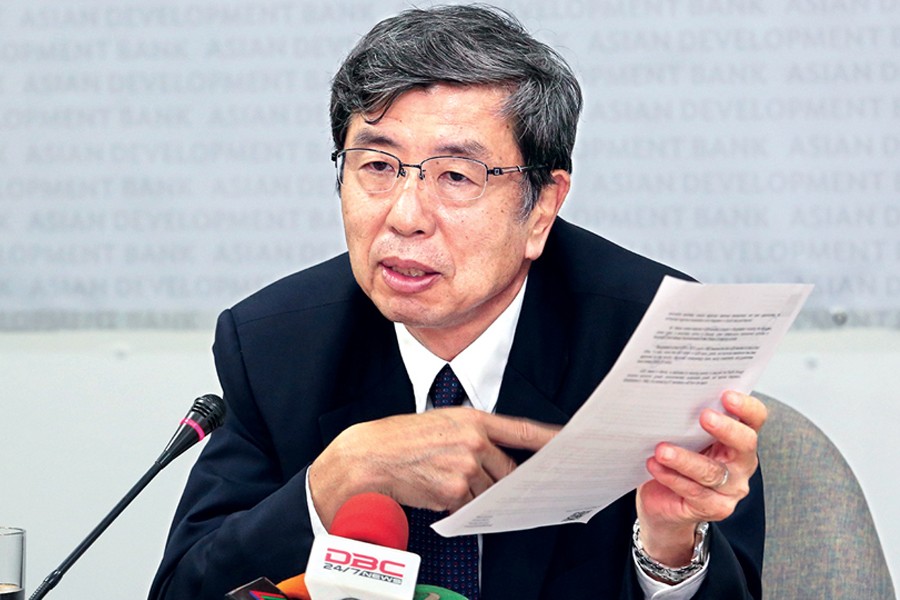
Growth not enough to be MIC, inequality prevails
ADB president says about Bangladesh status, advises tapping 'geographical advantage'
FE Report | Thursday, 1 March 2018

Asian Development Bank (ADB) President Takehiko Nakao finds Bangladesh's economic growth not enough to become a higher-middle-income country (MIC) in the set timeline and says inequality a major problem.
"It is not impossible, but it's not easy. Today (Bangladesh's) per-capita GDP is about $1500. But for higher MIC it may require $12,000. So if it maintains 7.0 percent-plus growth in terms of per-capita GDP, it is less than that (required) ….It will require like Chinese per-capita-income growth. So, if Bangladesh can grow as much as China is expanded, it could achieve the target," he said in Dhaka Wednesday.
While offering his institution's help in dealing with development issues, the ADB chief said higher investment in infrastructure, better investment climate, and extended foreign direct investment (FDI) growth like in Vietnam are an imperative.
While briefing journalists at the ADB office in Dhaka at the end of his three-day tour, Mr Takao said Bangladesh's current level of investment is not enough to achieve the longer-term target of becoming MIC by 2041.
The ADB President assured Bangladesh of expanding financial support, including possible investment in the planned second Padma Bridge project.
"We have fund constraints. We support Bangladesh based on the COBP (country operation business plan) here. Moreover, if the government requests us, we will consider financing the proposed second Padma Bridge project," Mr Nakao said in reply to a question.
ADB Country Director Mr Manmohan Parkash added that if the government requested the Bank for financing any mega-projects, including second Padma Bridge, they would consider it.
The Manila-based lender scrapped its US$615 million worth of financing plan along with three other foreign donors -- the World Bank, Japan's JICA and the Islamic Development Bank (IDB) -- in 2012 for Bangladesh's first Padma Bridge, following allegations of graft by some government policymakers and officials.
The government later decided to construct the bridge with internal resources, and the bridge is now under construction at Mawa-Janjira point on the River Padma.
The second Padma Bridge is proposed to be built at Douladia-Paturia point, upstream from the Mawa-Janjira point on the mighty river.
The ADB President suggested Bangladesh tap potential geographical dividend for economic advances, as high-growth economies are around.
"Bangladesh can use the geographical advantage of being surrounded by countries like India and China, and Southeast Asia. It will be very useful for the country to grow at higher rate," he told the journalists.
The chief of the Asian development financier spotted some challenges facing increase in investment in infrastructure development, improving business climates, boosting FDI, upgrading the tax-GDP (gross domestic product) ratio and tapping geographical benefit.
About a so-called MIC 'trap', Mr Nakao said it is too early to comment whether Bangladesh is going to fall into the trap.
Asked about the coming political scenario ahead of national elections in Bangladesh, he said: "Although sometimes there is some ups and downs in policies, but I hope the country will continue its policies for infrastructure development. And the ruling party will follow it."
He would like to see stable policies, and better conditions, prudent fiscal policies. "There should be consistency. Then I hope this country will do better," he said as regards matters in the transitional time ahead.
Mr Takao termed the poverty eradication in national standards better. "Poverty is dramatically reduced here. I see in the rural areas that the poverty has been cut significantly. But inequality is a challenge for the countries across the world," he said.
The ADB, based on his firsthand experiences, mentioned that people who were brought up in the capital city are enjoying much more state facilities than others. "But in Bangladesh many people are enjoying the opportunities. But still some people are enjoying more than others. So, the country needs to pay attention to this issue," he said.
"Equality is very important for the country. I think this is the basic thing of the sustainable growth in Bangladesh," he added.
Mr. Nakao feels that Bangladesh is on track to continue its growth momentum and complimented the government for sound management of the economy. "Accelerating GDP growth through higher investment in manufacturing and key infrastructure is the right strategy," he said.
"Sustaining this progress, however, will require an improved investment climate for the private sector, better revenue mobilisation, and continued prudent macroeconomic management."
Hailing Bangladesh's handling of the influx of Myanmar's 688,000 Rohingya people since October 2017, the ADB chief said the lender will offer support to help the government address the crisis, if requested.
About ADB plan for bankrolling development recipe, Mr Takao said they would extend support depending upon need, performance of ongoing projects, and readiness of new projects in Bangladesh.
Under ADB's current Country Partnership Strategy for Bangladesh, it proposes a total of $8.0 billion in assistance, including for non-sovereign operations, during the period 2016-2020.
The proposed amount is 60 per cent up from $5.0 billion in 2011-2015. In 2016-2017 ADB approved $2.5 billion in sovereign and $600 million in non-sovereign assistance.
ADB President Takehiko Nakao met with Bangladesh Prime Minister Sheikh Hasina, Finance Minister AMA Muhith and other senior officials during his 3-day visit during which he committed to further strengthening ADB's 45-year partnership with the country.
In his meetings, Mr. Nakao reaffirmed ADB support to the government in formulating a comprehensive plan for developing an economic corridor in the southwest region to diversify economic activities, ensure regionally balanced development, and open opportunities for enhanced regional cooperation and integration in South Asia and beyond.
He visited selected ADB-assisted projects including the Ashuganj power plant, a secondary school in Bhairab, urban infrastructure-improvement activities in Narsingdi, and railway improvements in the Dhaka-Chittagong corridor.
kabirhuamayan10@gmail.com